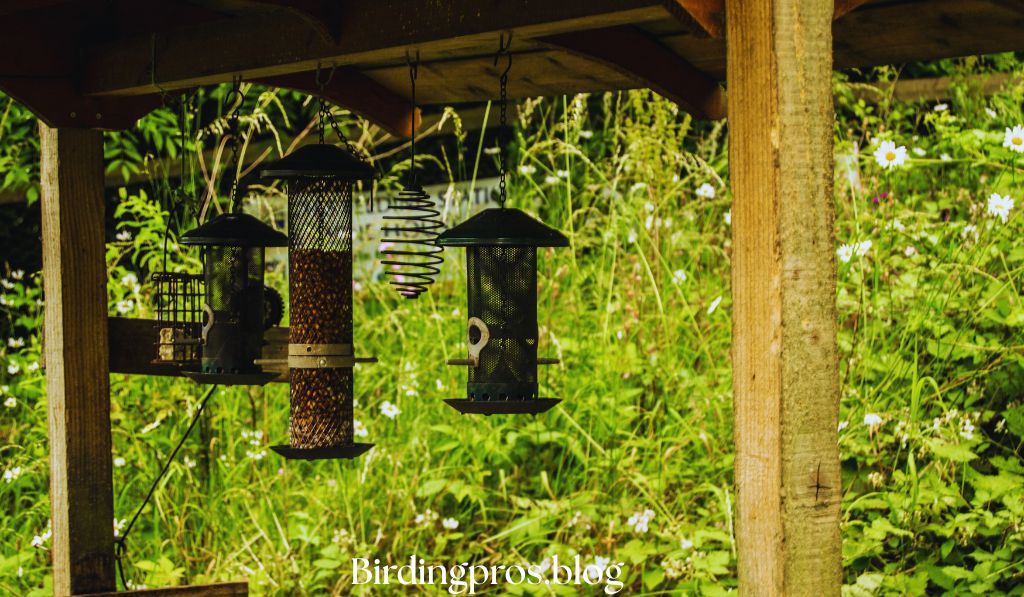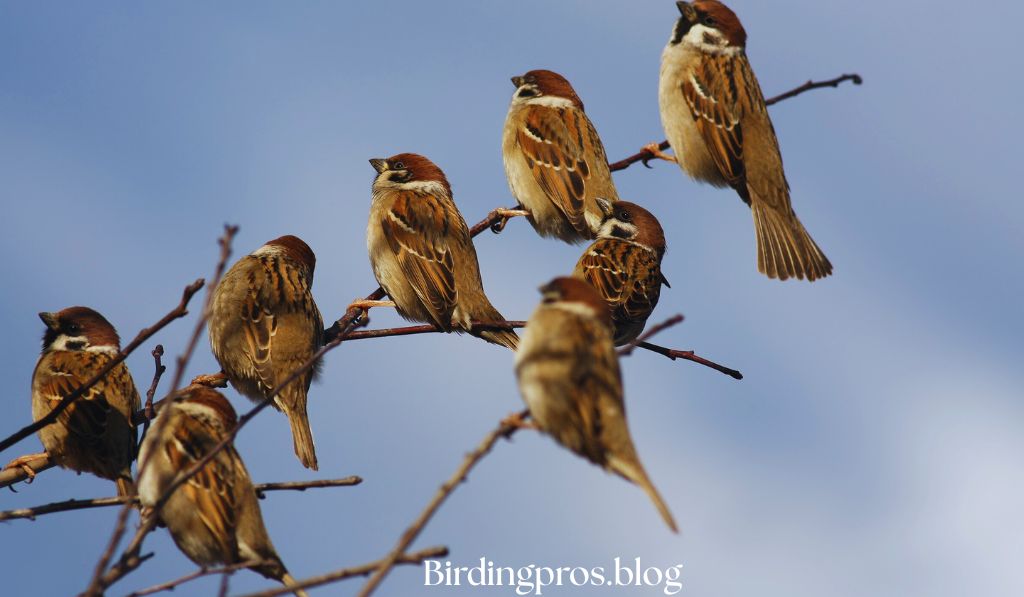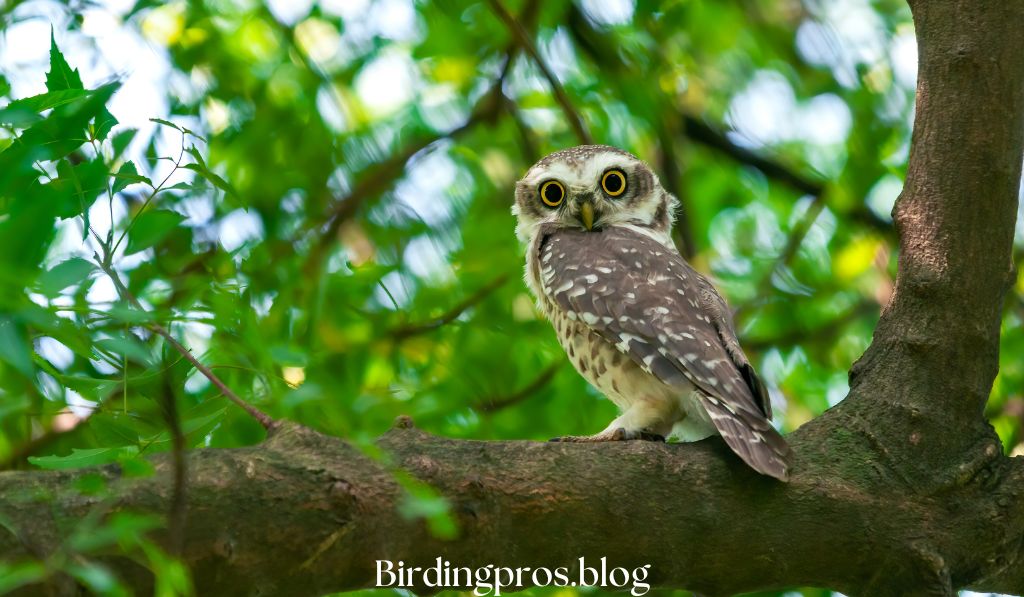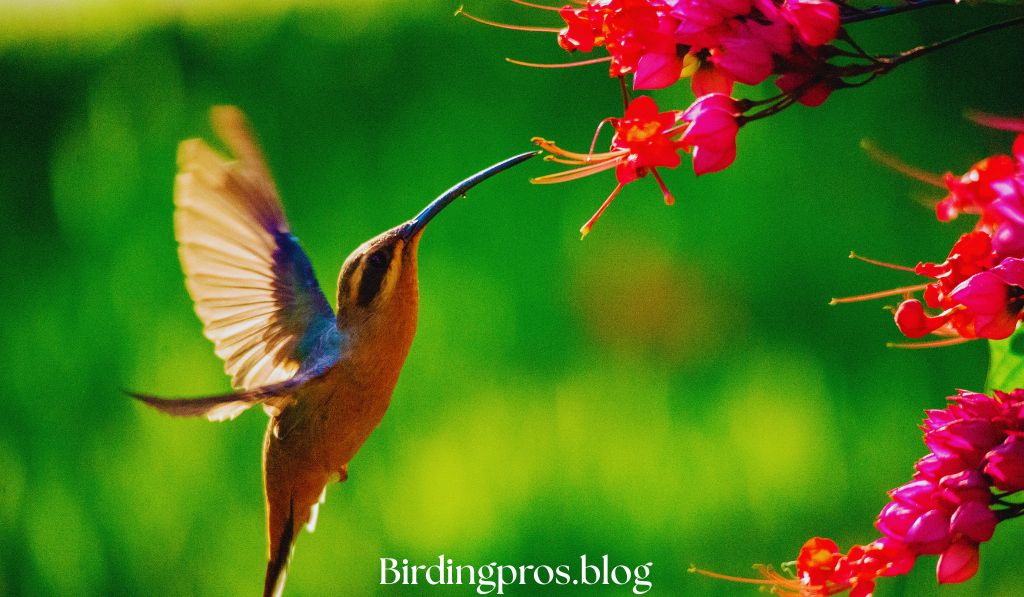Welcome to the final guide on putting in when feeders are outside! Attracting a numerous array of feathered visitors for your out of doors space is very worthwhile and academic.
Bird feeders create an inviting environment that brings nature right to your doorstep.
In this complete guide, we are going to explore the whole thing you want to realize about selecting, positioning, and retaining bird feeders to create the suitable feeding station for your avian friends.
Table of Contents
ToggleBenefits of Placing Bird Feeders in Your Backyard

Bird feeders redecorate normal gardens into colourful natural world sanctuaries. The advantages increase an extended manner beyond truly presenting nourishment for community birds.
Supporting Local Bird Populations
Bird feeders function as important useful resource systems for community avian corporations. They provide consistent nourishment even as herbal meals resources end up scarce.
During harsh climate conditions, hen feeders emerge as lifelines for plenty of species that battle to discover enough nutrients. Your thoughtfully positioned chook feeders assist birds conserve valuable energy they might otherwise burn up trying to find food.
Enhancing Personal Wellbeing
Bird feeders bring nature’s beauty at once for your residing space. The presence of colourful birds creates a peaceful environment that reduces strain and anxiety.
Many bird enthusiasts file progressed intellectual fitness from normal chicken watching at their bird feeders. The soothing sounds of chirping birds offer a natural form of treatment.
Children increase precious announcement competencies and environmental focus with the aid of monitoring chicken feeders. This early connection with flora and fauna fosters lifelong appreciation for conservation efforts.
Contributing to Citizen Science
Your chook feeders can play an essential function in medical studies. Many out of doors bird watchers take part in organized counting packages that music populace traits.
Organizations just like the Great Backyard Bird Count and Project FeederWatch make use of information from residential bird feeders nationwide.
These citizen technology projects help researchers recognize migration patterns and habitat modifications.
Recording the species that go to your chicken feeders creates precious information for ornithologists studying avian behavior. Your clean observations can make a contribution to important clinical discoveries.
Should I Feed Birds Regularly?
Consistency is high whilst preserving chicken feeders to your backyard. Birds quickly contain reliable feeding stations into their every day workouts.
Establishing Feeding Patterns
When you maintain properly-stocked fowl feeders, community birds come to rely upon your feeding station. This consistency builds accept as true with cautious species that might in any other case keep away from human-populated areas.
Regular feeding through fowl feeders enables birds to set up efficient foraging routes. They’ll incorporate your feeding station into their day by day patterns, mainly all through difficult seasons.
Birds often talk about the vicinity of reliable food assets to others in their species. A always maintained fowl feeder will step by step entice greater traffic as phrase spreads inside the avian network.
Seasonal Importance of Bird Feeders
Bird feeders become especially essential during wintry weather months at the same time as herbal food is scarce. The high-energy elements supplied help birds hold their frame temperature in bloodless weather.
During migration periods, chicken feeders provide essential refueling stations for traveling species. These stopover points can determine the achievement in their prolonged trips.
Spring brings nesting sports, and fowl feeders complement the prolonged strength wishes of breeding birds. Parent birds often go to feeders to collect meals for their hungry nestlings.
Responsible Feeding Practices
While keeping chook feeders frequently is useful, keep away from creating whole dependence. Natural foraging remains crucial for retaining wild birds’ instinctual behaviors.
If you intend prolonged absences, gradually lessen feeding to allow birds time to find alternative meals resources. Sudden disappearance of a dependable food supply can pressure regular site visitors for your bird feeders.
Clean your chicken feeders constantly to prevent sickness transmission. Regular upkeep ensures your feeding station remains a healthful useful resource in preference to a capacity risk.
What Bird Foods Should I Place in Bird Feeders?

The selection of meals for your fowl feeders without delay affects which species will visit. Different birds have awesome nutritional picks that attract them to unique sorts of feeders.
Popular Seed Options for Bird Feeders
Black oil sunflower seeds rank the numerous most flexible options for bird feeders. Their immoderate fats content material cloth and skinny shells cause them to accessible to several species, which incorporates:
- Cardinals
- Chickadees
- Titmice
- Nuthatches
- Finches
- Woodpeckers
Nyjer (thistle) seed attracts smaller finches to specialized chicken feeders. This tiny black seed calls for special feeders with small ports to prevent wastage.
Safflower seeds attract many proper songbirds whilst deterring squirrels and large pest birds. These white seeds work properly in maximum widespread chicken feeders.
Protein-Rich Foods for Bird Feeders
Suet gives critical fat and protein, in particular precious in wintry climate chicken feeders. This rendered pork fat appeals especially to:
- Woodpeckers
- Nuthatches
- Chickadees
- Wrens
- Warblers
Mealworms, whether stay or dried, entice insect-eating birds for your feeders. Bluebirds, robins, and warblers eagerly visit hen feeders stocked with those protein-packed treats.
Peanuts, every in-shell and shelled, offer great vitamins in hen feeders. Blue jays, woodpeckers, and titmice conveniently consume this electricity-dense food.
Specialty Foods for Specific Species
Nectar feeders cater in particular to hummingbirds and orioles. These specialised chook feeders contain sugar water that mimics the natural nectar those birds are trying to find.
Fruit feeders entice species that commonly do not go to seed-based chicken feeders. Orioles, tanagers, and mockingbirds recognize services of orange halves, grape jelly, or apple portions.
Mixed seed blends can diversify visitors for your fowl feeders. High-first-rate mixes without fillers like milo or wheat entice a greater variety of species.
Foods to Avoid in Bird Feeders
Never region bread, crackers, or specific processed human ingredients in chook feeders. These items lack proper vitamins and may cause health troubles for birds.
Avoid any foods with brought salt, sugar, or synthetic components in your chook feeders. These components may be risky to avian website site visitors.
Chocolate, caffeine, and alcohol ought to in no way appear in chicken feeders. These substances are poisonous to birds even in small portions.
Bird Food Variation Throughout the Seasons

Bird feeding requirements trade with the seasons. Adapting your chicken feeders’ offerings to in shape seasonal wishes draws unique species at a few degrees within the twelve months.
Winter Bird Feeder Offerings
During wintry climate months, bird feeders ought to encompass excessive-fats components to assist birds preserve frame warmth. Suet, peanuts, and black oil sunflower seeds offer important strength.
Winter hen feeders require extra common refilling as birds consume extra food to live warmth. Consider installing multiple feeding stations to lessen competition.
Snow and ice can restrict natural meals accessibility, making your hen feeders important assets. Maintain normal feeding schedules even throughout harsh weather situations.
Spring Bird Feeder Selection
Spring brings nesting activities, growing protein demands at your bird feeders. Offering mealworms and suet facilitates discern birds feed developing nestlings.
Calcium will become important for egg-laying ladies touring your hen feeders. Crushed eggshells (baked and cooled) offer this essential mineral.
Continue presenting seeds on your chook feeders whilst step by step introducing extra protein-wealthy options. This variety supports birds via the strength-widespread breeding season.
Summer Bird Feeder Maintenance
Summer hen feeders require extra common cleansing because of warmth and humidity. Prevent mildew growth by means of clean seed each few days in the route of warm climate.
Natural food resources become more abundant in the summer season, however many birds despite the fact appreciate supplemental bird feeders. Continue supplying masses of seeds, nectar, and culmination.
Nectar feeders need unique attention in some unspecified time in the future of summer time months. Clean those specialised bird feeders every 2-3 days to prevent dangerous fermentation.
Autumn Bird Feeder Preparation
Fall migration brings new site visitors on your fowl feeders. Stock up on excessive-power ingredients to assist birds getting prepared for long journeys.
Many birds build fat reserves in autumn, making your chook feeders an important calorie property. Black oil sunflower seeds, peanuts, and suet help birds put together for winter or migration.
Consider increasing your hen feeder array in autumn to deal with elevated visitors. Multiple feeding stations reduce competition and territorial disputes.
How to Set Up Bird Feeders in Backyard

Strategic placement of hen feeders complements both chook protection and viewing entertainment. Consider those elements while organising your feeding stations.
Selecting Optimal Locations for Bird Feeders
Position chicken feeders wherein birds can without issue spot them however additionally get proper of entry to shut by way of cover. Bushes or trees within 10-15 ft offer brief break out routes from predators.
Avoid placing chicken feeders immediately against domestic home windows to prevent collision accidents. Either function feeders very near (inside 3 feet) or farther away (beyond 30 toes) from glass surfaces.
Consider sun publicity at the same time as positioning your fowl feeders. Some coloration prevents seed from spoiling rapidly in warm climates.
Bird Feeder Height Considerations
Hanging fowl feeders at eye level gives maximum reliable viewing however can also disclose birds to predators. Evaluate your unique surroundings when figuring out the top.
Pole-installed fowl feeders permit bendy positioning and can consist of predator guards. A height of 5-6 toes typically balances visibility with safety.
Different species choose feeding at one-of-a-kind heights. Installing more than one fowl feeders at numerous ranges draws a more numerous avian community.
Creating a Complete Feeding Station
Incorporate water assets close to your chook feeders to create a complete habitat. Birds require ingesting and bathing options alongside meal sources.
Plant local flora spherical fowl feeders to offer natural refuge and further meals resources. These plant life complement your feeding software at some level within the one year.
Consider adding nesting boxes close to hooked up chicken feeders. Many birds that revel in your feeding station also can pick to nest nearby if appropriate housing is available.
How to Choose the Best Bird Feeders for Your Backyard
The fashion and construction of fowl feeders drastically affect which species will go to. Different designs accommodate various feeding behaviors and food kinds.
Types of Bird Feeders
Tube bird feeders feature cylindrical designs with more than one feeding port. These flexible feeders work nicely with most seed sorts and lure a massive form of birds.
Platform or tray fowl feeders provide open feeding regions to be had to ground-feeding species. These clean structures accommodate larger birds that can not perch on tube feeders.
Hopper hen feeders resemble small houses with seed reservoirs that regularly dispense meals. These durable stations shield seed from weather whilst serving many fowl species.
Specialized Bird Feeder Designs
Nyjer seed chook feeders function as tiny ports specifically designed for thistle seed. These specialized feeders attract goldfinches, siskins, and unique small finches.
Suet cage fowl feeders secure suet cakes even as allowing woodpeckers and one-of-a-kind birds to hang and feed. Their easy wire introduction gives essential grip for huge birds.
Nectar fowl feeders with specifically designed ports serve hummingbirds and orioles. These one in all a kind feeders typically feature pink coloration to attract target species.
Construction Quality Considerations
Weather-resistant bird feeders offer lengthy-time period prices irrespective of higher preliminary expenses. Look for UV-resistant plastics, powder-lined metals, or cedar production.
Easy-easy chook feeders sell higher hygiene in your avian website online traffic. Models that disassemble without equipment make everyday upkeep more available.
Squirrel-resistant chicken feeders consist of particular capabilities like weight-activated perches or protective cages. These designs assist in making certain that chicken meals reach your meant recipients.
When to Clean Bird Feeders

Regular safety of chicken feeders prevents disease transmission and ensures your feeding station remains useful in preference to risk.
Cleaning Schedule for Bird Feeders
Standard seed chicken feeders require cleaning each two weeks throughout everyday climate. During heat, humid conditions increase frequency to weekly cleanings.
Nectar fowl feeders want cleansing every 2-three days to prevent dangerous fermentation. Mold grows rapidly in sugar solutions, especially throughout warm weather.
Suet fowl feeders have to be wiped clean month-to-month and checked often for mold or discoloration. Replace suet cakes that show any symptoms of spoilage properly.
Effective Cleaning Methods
Disassemble fowl feeders actually for thorough cleansing. Most designs permit easy disassembly without unique gear.
Soak fowl feeder components in an answer of one part bleach to 9 parts water for 10 minutes. This mixture efficiently kills bacteria and mold spores.
Scrub chicken feeders with a bottle brush to put off cussed particles. Pay particular interest to corners and feeding ports in which seed residue accumulates.
Maintenance Beyond Cleaning
Inspect chicken feeders often for harm or placed on. Replacing cracked additives is the proper way to save you harm to traveling birds.
Check striking hardware on bird feeders month-to-month to ensure strong attachment. Weather and use can step by step weaken hooks, cables, or chains.
Clear collected seed hulls underneath bird feeders to save you mould boom and rodent appeal. This simple upkeep step maintains your feeding place healthfully.
Common Challenges with Bird Feeders
Even well-maintained fowl feeders can encounter troubles. Understanding common problems facilitates making certain your feeding software program remains beneficial.
Deterring Unwanted Visitors
Squirrels frequently raid bird feeders, ingesting huge portions of seed. Consider specialised squirrel-evidence feeders or baffle structures to guard your hen food.
Large competitive birds can also dominate your feeding stations. Installing separate chicken feeders with smaller perches can help smaller species get admission to food.
Raccoons and other nocturnal mammals may additionally goal chicken feeders. Bringing feeders indoors at night time or the use of specialized resistant fashions reduces the ones encountered.
Managing Seed Waste Around Bird Feeders
Seed hulls collect fast below busy fowl feeders. Consider putting in seed catchers or choosing hulled seed types to reduce debris.
Sprouting seeds underneath hen feeders can create unwanted plant life. Regular cleanup prevents unwanted plant increase in your yard.
Some birds scatter seed whilst feeding at chicken feeders. Selecting no-mess seed blends reduces waste from selective feeding behaviors.
Addressing Health Concerns
Mold can increase in damp fowl feeders, causing respiratory illnesses in birds. Regular cleansing and right drainage prevent this dangerous situation.
Overcrowding at chook feeders increases illness transmission chances. Installing more than one feeding stations reduces competition and ability contagion.
Window movements close to fowl feeders injure many birds yearly. Special window decals or optimized feeder placement reduces this danger.
FAQs About Setting Up Bird Feeders
Beginners often have questions on putting in effective fowl feeders. These commonplace inquiries deal with essential concerns about outdoor feeding.
How often ought to I replenish my fowl feeders?
Check chicken feeders every 1-2 days inside the direction of pinnacle feeding seasons. Regular tracking prevents feeders from finally emptying for extended durations.
Winter bird feeders can also require each day refilling as birds consume extra energy. Summer feeders commonly want tons much less common attention except you have got a particularly lively hen network.
Establish a steady agenda for checking your chook feeders. Birds rapidly study feeding patterns and will go to hence.
How can I prevent squirrels from raiding my bird feeders?
Install specialized squirrel-evidence hen feeders with weight-activated mechanisms. These clever designs near get entry to meals whilst heavier animals attempt to feed.
Position bird feeders as a minimum 10 ft from jumping elements including wooden or systems. This distance exceeds the jumping ability of most squirrels.
Add baffles above and below pole-installed chook feeders. These smooth devices save you squirrels from climbing to gain your feeding stations.
Should I provide water alongside my fowl feeders?
Water draws many species that may not visit seed-first-class chicken feeders. A smooth birdbath enhances your feeding software program fantastically.
Birds require water for ingesting and bathing yr-spherical. Heated water resources near wintry climate chook feeders are mainly treasured at some stage in freezing conditions.
Moving water attracts more hobbies than still water. Consider such as a dripper or mister near your bird feeders at some point of warm months.
Conclusion
Setting up hen feeders for your outdoors creates a welcoming environment for nearby and migratory birds. These easy structures provide crucial vitamins whilst bringing nature’s splendor right away in your residing vicinity.
By selecting appropriate bird feeders, supplying varied food options, and retaining smooth feeding stations, you set up a precious useful resource to your avian pals. The relationships you assemble through everyday feeding improve your life and the birds that go to your yard.
Remember that your fowl feeders are more than really meals assets—they are connections to the herbal international. The time you spend money on nicely preserving your feeding stations rewards you with limitless possibilities to look at and respect the wonders of untamed birds.
Start small with one or simple chook feeders, then amplify your services as you find out which species go to your outdoors. Soon, your outside will redesign right into a colorful bird sanctuary that gives satisfaction during the changing seasons.
Related posts
1. Birdwatching for Kids: A Complete Guide to Nature’s Winged Wonders
2. Best Birding Lodging in Panama: The Ultimate Guide to Top 10 Destinations






